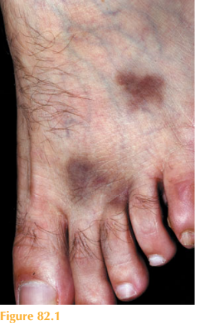History
A 56-year-old Albanian man presents to the dermatology clinic with a 2-year history of developing asymptomatic purple lesions on his skin. The initial lesions appeared on his feet 4 months after an orthoptic liver transplant for hepatitis B. Over the past few months he has developed further cutaneous lesions on his legs, arms and trunk. He is taking systemic prednisolone and tacrolimus.
Examination
There are well-demarcated macular purple patches on his shoulder, forearms, dorsi of his hands, right calf and left foot. The lesions on the left foot and medial shin are indurated, firm plaques (Fig. 82.1). The mouth, genitals, scalp and nails are normal.


Questions
• What is the cause of the skin lesions?
• What is the aetiological agent?
• How would you manage this patient?
Cutaneous lesions with a vascular origin frequently appear as purple discolouration, including purpura, vasculitis, livedo, vascular occlusion (thrombosis) and vascular prolif-erations (benign or malignant). When blood vessels proliferate there may be a palpable component to the skin lesions such as papules, patches, plaques or nodules.
This Albanian patient presented with multiple, asymptomatic, palpable, purple skin lesions on a background of immunosuppression, leading to a clinical diagnosis of Kaposi’s sarcoma (KS). This was confirmed histologically by taking a skin biopsy. The his-topathology showed the classic spindle cells surrounding slit-like spaces with red blood cells; staining for human herpes virus type 8 (HHV-8) was positive.
This patient’s HIV test was negative, and he was therefore diagnosed with disseminated endemic KS. The immunosuppressive medication he was taking for his liver transplant had allowed the proliferation of KS-associated herpes virus (thought to be HHV-8) lead-ing to the development of clinical KS lesions. In the context of transplantation these patients are thought to harbour the latent oncogenic herpes virus, which then reactivates leading to the development of malignant vascular tumours. KS classically affects the skin but mucosal tissue and systemic involvement may also occur. This patient’s CT scan was negative for KS lesions in the lung.
So-called iatrogenic KS in liver and renal transplant patients poses a therapeutic chal-lenge. The tumour is chemosensitive and radiosensitive. However, in the context of trans-plantation, adjustment to the immunosuppressive medication can be highly successful.
This patient was switched from tacrolimus to sirolimus (rapamycin) with regression of the tumours. Sirolimus is immunosuppressive and has anti-tumour properties.
Recent evidence from laboratory studies has shown that the tumour is stimulated by iron salts. Transplant recipients often receive multiple blood transfusions leading to possible iron overload, and consequently leave them more susceptible to KS than other iatrogeni-cally immunosuppressed patients.
KEY POINTS
• Kaposi’s sarcoma (KS) is a malignant vascular tumour that occurs in endemic areas, in HIV carriers and organ transplant recipients.
• Immunohistochemical staining for HHV-8 is positive from KS lesions.
• KS in transplant patients can be managed by adjusting the immunosuppressive medication.
need an explanation for this answer? contact us directly to get an explanation for this answer